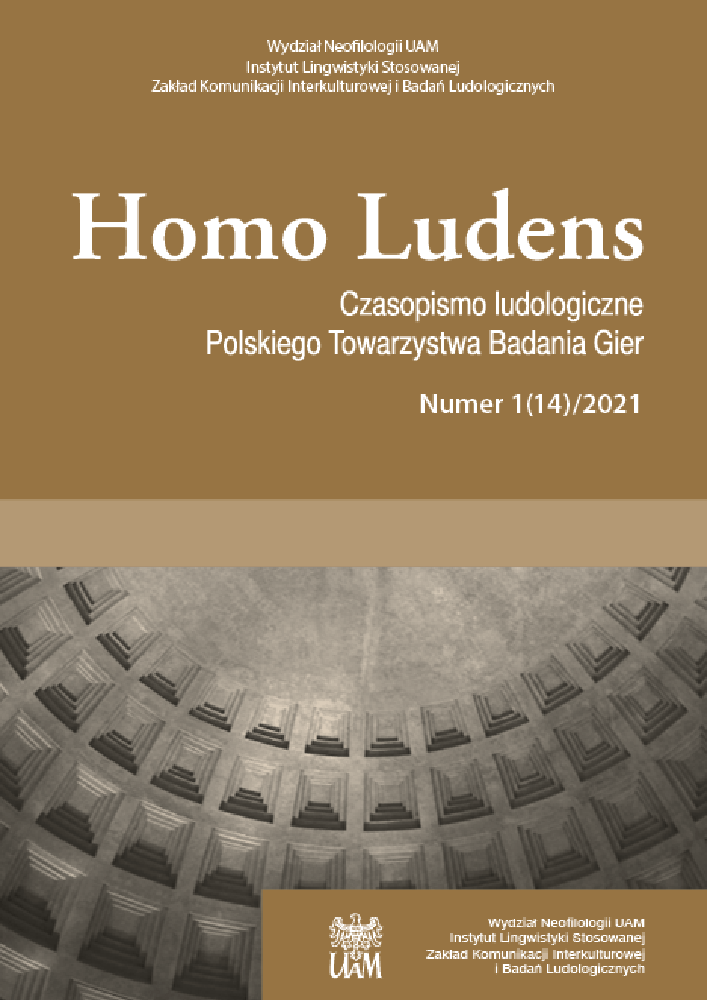Abstract
Survival horror games are stereotypically dated back to the 1990s. This article aims to trace the origin of this genre in the 1980s. The author
examines selected games created in France in that decade. Then he argues that titles such as Infernal Runner, Le Pacte and Zombi had already shaped the poetics of survival horror games. This poetics relies on the iconography of literature and horror movies, the terror directed against the controlled avatars, the confrontation with objects evoking the effect of horror and the simulation of mental states of the characters.
References
Adams, E. (2009). Fundamentals of game design. Berkeley: New Riders.
Anson, J. (2019). Amityville horror (tłum. M. Machała). Czerwonak: Vesper.
Blanchet, A., Montagnon, G. (2020). Une histoire du jeu vidéo en France: 1960–1991: des labos aux chambres d’ados. Houdan: Éditions Pix’n Love.
Caberia, É. (1987). Massacre. Tilt, 46, 134. Online: <https://archive.org/details/Tilt046>.
Caracciolo, M. (2014). The experientiality of narrative: An enactivist approach. Berlin: De Gruyter.
Egenfeldt-Nielsen, S., Smith, J. H., Tosca, S. P. (2015). Understanding video games: The essential introduction. New York – London: Routledge.
Fahs, T. (2012). IGN presents the history of survival horror. Online: <https://uk.ign.com/articles/2009/10/30/ign-presents-the-history-of-survival-horror>.
Godzic, W. (1991). Film i psychoanaliza. Problem widza. Kraków: Wydawnictwo Uniwersytetu Jagiellońskiego.
Habel, C., Kooyman, B. (2014). Agency mechanics: Gameplay design in survival horror video games. Digital Creativity, 25(1), 1–14.
Holmquest, B. (2014). Survival horror, metaculture and the fluidity of video game genres. W: N. Farghaly (red.), Unraveling Resident Evil:
Essays on the complex universe of the games and films (s. 62–79). Jefferson: McFarland & Company.
Jankowski, F. (2015). Przegrana tymczasowa, przegrana permanentna. Ludyczny i egzystencjalny charakter porażki w dwóch wersjach gry
Infernal Runner. Mała Kultura Współczesna, 6(3). Online: <https://bit.ly/2JpIIft>.
Kirkland, E. (2005). Restless dreams in Silent Hill: Approaches to video game analysis. Journal of Media Practice, 6(3), 167–178. Online:<https://www.ingentaconnect.com/content/intellect/tmsd/2005/00000006/00000003/art00005>.
Kjeldgaard-Christiansen, J., & Clasen, M. (2019). Threat simulation in virtual limbo: An evolutionary approach to horror video games. Journal of Gaming & Virtual Worlds, 11(2), 119–138. Online: <https://doi.org/10.1386/jgvw.11.2.119_1>.
Krzywinska, T. (2015). Gaming horror’s horror: Representation, regulation, and affect in survival horror videogames. Journal of Visual Culture, 14(3), 293–297. Online: <https://doi.org/10.1177/1470412915607924>.
Loriciels (1985a). Covers – L’Aigle d’or. CPC Rulez. Online: <https://cpcrulez.fr/GamesTest/l_aigle_d_or.htm>.
Musiał, Ł. (2011). Kafka: W poszukiwaniu utraconej rzeczywistości. Wrocław: Atut.
Perron, B. (2004). Sign of a threat: The effects of warning systems in survival horror games. W: A. Clarke (red.), COSIGN 2004 Proceedings (s. 132–141). Split: University of Split. Online: <http://www.cosignconference.org/downloads/papers/perron_cosign_2004.pdf>.
Perron, B. (2018). The world of scary video games: A study in videoludic horror. New York: Bloomsbury Publishing.
Poniewierski, Z. (2018). L’Aigle d’or. Francuska rewolucja w opowiadaniu historii. Pixelpost. Online: <http://pixelpost.pl/laigle-dor-rewolucja-francuska-w-opowiadaniu-historii/>.
Poremba, C. (2007). Point and shoot: Remediating photography in gamespace. Games and Culture, 2(1), 49–58. Online: <https://journals.sagepub.com/doi/10.1177/1555412006295397>.
Quémard, C. (1987). Ubi Soft, vous connaissez? Arcades, 1(3), 116–118. Online: <https://archive.org/details/arcades-hebdo-magazine-03>.
Reed, C. (2016). Resident Evil’s rhetoric: The communication of corruption in survival horror video games. Games and Culture, 11(6), 625–643. Online: <https://journals.sagepub.com/doi/10.1177/1555412015575363>.
Schott, G. (2010). Dawn of the digital dead: The zombie as interactive social satire in American popular culture. Australasian Journal of American Studies, 29(1), 61–75. Online: <https://www.jstor.org/stable/41054186>.
Staszenko, D. (2014). Motyw „yūrei” w japońskich survival horrorach –analiza wybranych przykładów. Replay. The Polish Journal of Game Studies, 1(1), 30–38.
Stoker, B. (2015). Dracula (tłum. A. Myśliwy). Kraków: Wydawnictwo vis-à-vis/Etiuda.
Taylor, L. N. (2014). Gothic bloodlines in survival horror gaming. W: B. Perron (red.), Horror video games: Essays on the fusion of fear and play (s. 46–61). Jefferson: McFarland.
Therrien, C. (2009). Games of fear: A multi-faceted historical account of the horror genre in video games. W: B. Perron (red.), Horror video games: Essays on the fusion of fear and play (s. 26–45). Jefferson: McFarland.
Żmuda, M. (2012). Horror w grach komputerowych: Poetyka grozy a gatunek survival horror. W: A. Pitrus (red.), Olbrzym w cieniu. Gry wideo w kulturze audiowizualnej (s. 205–215). Kraków: Wydawnictwo Uniwersytetu Jagiellońskiego.
Data dostępu do źródeł internetowych wykorzystanych w tekście: 8 czerwca 2021.
Filmografia
Corman, R. (1960). Sklepik z horrorami [DVD]. American International Pictures.
Dante, J. (1981). Skowyt [DVD]. AVCO Embassy Picture.
Rosenberg, S. (1975). Horror Amityville [DVD]. American International Pictures.
Romero, G. A. (1978). Świt żywych trupów [DVD]. Dawn Associates.
Ludografia
Capcom (1996). Resident Evil [PS]. Capcom, Japonia.
Capcom (2006). Dead Rising [gra wieloplatformowa]. Capcom, Japonia.
Eden Games (2008). Alone in the Dark [gra wieloplatformowa]. Atari, Francja.
Infogrames (1992). Alone in the Dark [PC]. Infogrames, Francja.
Japan Studio (2003. Forbidden Siren [PS2]. Sony Computer Entertainment, Japonia.
Le Breton, J.-L. (1983). Le Vampire Fou [Apple II]. Ciel Bleu, Francja.
Loriciels (1984b). L’Aigle d’or [gra wieloplatformowa]. Loriciels, Francja.
Loriciels (1985). Infernal Runner [C64, Amstrad CPC]. Loriciels, Francja.
Loriciels (1986a). Le Pacte [Amstrad CPC]. Loriciels, Francja.
Loriciels (1986b). Massacre dans la 520ème dimension [Atari ST]. Loriciels, Francja.
Playdead (2010). Limbo [gra wieloplatformowa]. Playdead, Dania.
Tecmo (2001). Fatal Frame [PS2]. Tecmo, Japonia.
Ubi Soft (1986). Zombi [gra wieloplatformowa]. Ubi Soft, Francja.
Ubi Soft (1987). La Chose de Grotemburg [Amstrad CPC]. Ubi Soft, Francja.
Ubi Soft (1988). Hurlements [gra wieloplatformowa]. Ubi Soft, Francja.
Valve South (2008). Left 4 Dead [gra wieloplatformowa]. Valve, USA.
Yob, G. (1973). Hunt the Wumpus [PC]. People’s Computer Company, Japonia.

